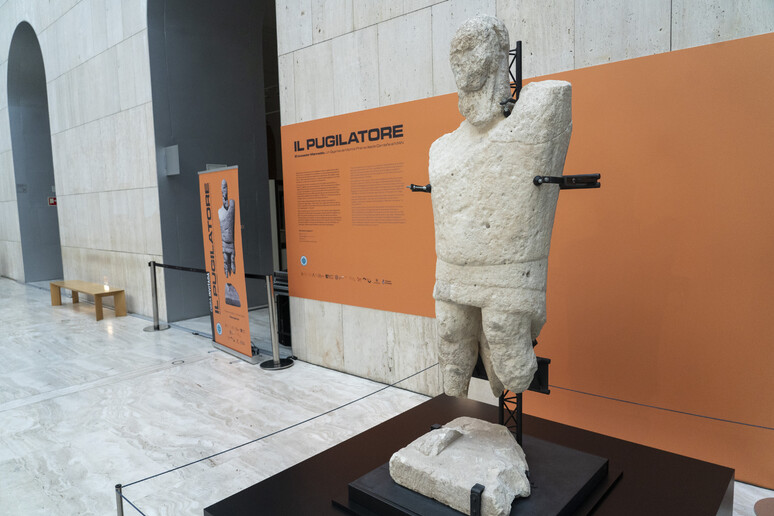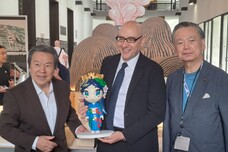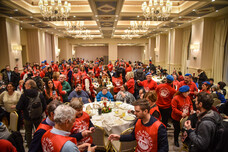by Paola Del Vecchio
From the pantheon to the
archaeological site of Cabras, in western Sardinia, to Madrid:
Maneddu, one of the celebrated and mysterious Giants of Mont'è
Prama, is the absolute protagonist of an exhibition inaugurated
at the National Archaeological Museum (MAN) of the Spanish
capital.
The show will run until January 12, 2025.
Madrid welcomed the over two-metre-high stone giant, which dates
back to 900-750 BC, ambassador abroad of the over 30 Nuragic
limestone sculptures rebuilt after they were discovered by
chance in 1974, on Mont'e Prama, in the peninsula of Sinis near
Oristano.
An army of archers, boxers and warriors from the Iron Age, found
after the first excavation work, originally aligned along the
necropolis used 3,000 years ago and where, with the system of
anthropomorphic sculptures Nuraghe and sacred stones have
emerged.
"It's one of the most important and ancient groups of sculptures
of human representations of the western Mediterranean - having
it here is a dream come true", said the director of the
archaeological museum, Isabel Izquierdo Peraile, inaugurating
the exhibition, which was possible thanks to the synergy between
the MAN, the Italian and Spanish culture ministries, the Italian
embassy in Spain, the Foundation Mont'e Prama and the Italian
cultural institute.
"It is an opportunity of exceptional collaboration which opens a
window on Italian and Sardinian archaeology", she said.
Maneddu "dialogues with other Spanish sculptures in stone and
bronze, dating back to the Iron Age of the first millennium BC -
as the funerary monument of Pozo Moro, from the end of the 6th
century BC which, like the funerary fence of Mont'Prama became a
place of worship for ancestors", Izquierdo told ANSA.
A major event for a double celebration: the 50 years since the
discovery of the archaeological settlement on the hill of Cabras
and the tenth anniversary of the architectural renovation of
MAN.
"Without a doubt, the giants are the most evident proof that in
the Mediterranean even before the Roman rule relations were very
strong between western Sardinia, the Balearic Islands and
eastern Spain", stressed Italy's ambassador to Spain, Giuseppe
Buccino Grimaldi, who inspired the exhibition project.
"The discovery of the giants is extraordinary for the
archaeology of Mare Nostrum (our sea in Latin, the
Mediterranean), it has brought to the need to revise
interpretations.
"Given the lack of documents, they all go in the Spain of an
already close relationship in 1,000 BC, when it was thought that
a similar statue could only exist in Egypt".
The relations were discussed at a scientific congress on "Spain,
Sardinian and the Aegean World in the Mediterranean" which on
September 17-18 offered an important occasion of debate between
archaeologists, researchers and representatives of institutions
that preserve, restore and promote cultural heritage.
Carlo Tronchetti, who was in charge of excavation work between
1977 and 1979 on Mont'e Prama was the guest of honour on the
first day.
"This exhibition in Madrid represents the culmination of our
international initiatives to enhance our archaeological park,
after prestigious exhibits at the Hermitage in Saint Petersburg
and at the Metropolitan Museum in New York", said Anthony
Muroni, president of the foundation Mont'e Prama, who
relentlessly carries out research and activities to promote the
archaeological area of Sinis.
"This is not only a promotional matter, there is a common
research project to understand what happened in the rest of the
western Mediterranean when in Sardinia the Giants of Mont'e
Prama were being sculpted.
"So a dialogue leading to new initiatives of study and research
has started", he added.
This will be yet another bridge in fertile relations between
Italy and Spain.
"The present of the Boxer in Madrid is an extraordinary
opportunity to share with the Spanish public a great discovery
that belongs to a universal heritage", said the director of the
Italian culture institute in Madrid, Marialuisa Pappalardo.
ALL RIGHTS RESERVED © Copyright ANSA











